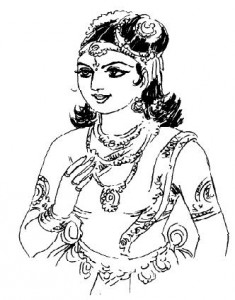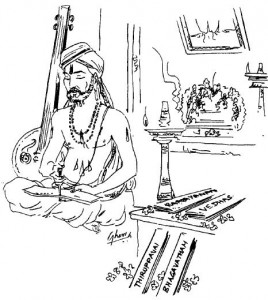A study of the compositions of Saint Tyagaraja reveals he was profoundly influence by Sri Andal’s Tiruppavai
When one thinks of the month of MARGAZHI, needless to say Tiruppavai, Goda Devi’s garland of immortal hymns, occupy the mind. Such is the greateness of these thirty hymns, recited by one and all, with devotion and religious fervor, during the month of Margazhi.
Sri Goda Devi, otherwise known as Andal, was the manifestation of Bhoomi Piratti(BhooDevi) and was brought up by Sri Periyazhwar(Vishnu Chittar) as his foster daughter. From her childhood Andal developed and ardent and unshakable devotion toward Lord Krishna which resulted in her determination to marry the Lord Himself and none else. She even went to the extent of declaring that she would not live, if she was proposed to a human being (Maanidarkku endru pecchu padil vaazhakillen manmadhane).
On learning from her father that gopi-s in NANDAVRAJA married Lord Krishna after performing vrata during the month of Margazhi, Sri Andal decided to emulate this.  To her Srivilliputhur was Nandavraja, the presiding deity Vatapatra saayee was Lord Krishna, the temple tank was river Yamuna and her friends were gopi-s . In short she mentally lived as gopi of Dwapara yuga. Thus Sri Andal composed Tiruppavai, the garland of immortal hymns in chaste tamil, which is known not only for devotion, but also for its literary value. Vedanta Desika says that he could understand the Divya Prabandham’s of other azhvars only after studying the Tiruppavai.
To her Srivilliputhur was Nandavraja, the presiding deity Vatapatra saayee was Lord Krishna, the temple tank was river Yamuna and her friends were gopi-s . In short she mentally lived as gopi of Dwapara yuga. Thus Sri Andal composed Tiruppavai, the garland of immortal hymns in chaste tamil, which is known not only for devotion, but also for its literary value. Vedanta Desika says that he could understand the Divya Prabandham’s of other azhvars only after studying the Tiruppavai.
These hymns are so popular that great acharya-s have written many commentaries. Tiruppavai is said to be the seed of all veda-s and each word is pregnant with many noble ideas/meanings. Each hymn (paasuram) consists of eight lines and can enjoy much more when listening to its musical rendering.
Sadguru Tyagaraja
Sri Tyagaraja, most popular among the Musical Trinity, was born in the 18th century(1767) and was considered to be the manifestation of sage Valmiki. His songs, known as kriti-s are soaked in devotion for Lord Rama. In most of his songs, he advocates the VISISHTADVAITA philosophy. He explains the greatness of ASHTAKSHARA, DVAYA, etc., and also stresses the importance of praying to both the Lord and His Consort LAKSHMI (Divine Couple). Obviously he must have read the works of great scholars before his time and included their ideas in his songs.
In this article, adiyen would like to illustrate how, phrases used by Sri Andal in her Tiruppavai influenced Saint Tyagaraja in composing some of his kritis.
1. In the first paasuram, “Margazhi thingal madi niraintha Nannaalaal” (In the auspicious month of Margazhi known for its moonlit nights), Sri Andal refers to two unique features of Lord viz., kar-meni (dark body) and chenkan (red eyes). Tyagaraja has also mentioned about the colour of the Lord, being like dark cloud in many kriti-s like :
(a) Shyaama-sundaraanga sakala shaktiyu neeveraa – (Dhanyaasi Raaga, roopaka Thaala) (O Lord with dark, beautiful body! You are the embodiment of all powers)
(b) Ghana neela! Navya vanamaaalika – aabharana! -(Song beginning: Elaa nee daya raadu – (Athaanaa raga, aadi thaala)(O Lord with body dark like a cloud, bedecked with the VANAMALA garland!)
(c) Navamegha theja!(Song beginning: Gaana moorthe! Sree Krishna! Venu gaana lola! – (MELA III raga, Desaadi thaala) (O Lord Krishna, embodiment of music and lover of flute!). in one particular song he gives the description of the unique combination viz., kaar meni andchenkann in the following song: (Suddaseemanthini raga, aadi thaala)
Pallavi – Jaanaki Ramana Bhakta Paarijaata!
Anupallavi – Gaanalola Ghana Thamaala Neela
Charanam – Rakthanalinadala -nayana
(O Consort of Janaki! The desire-yielding tree for the deveotees! One who is fond of music, dark in complexion like a cloud and a TAMALA-tree!… One with eyes resembling petals of red lotus!)
In the anupallavi, Tyagaraja regers to the Lord’s colour as Ghana tamaala neela and in the charanam, he describes His eyes as rakta nalinadala.
Hence we can draw the logical conclusion that he must have got this idea after seeing Sri Andal’s description kaarmeni chenkan in the Tiruppavai song referred to above.
2. In song 5, Maayanai mannu vada Madurai maindanai (Lord Krishna full of wonder and glory, born at Mathura) Sri Andal advocates that to ward off one’s sins and to overcome obstacles, one should sing the Lord’s glory, meditate on His name and worship Him. Here she refers to Lord Krishna as Damodara, one who got the name after He was tied with a ropy by Yasoda (having the mark of the rope on his stomach).
Sri Tyagaraja, both in his kriti-s, kadathera raadaa manasaa(Thodi raga, Mela 8, Desadai thaala) (O my mind! Should you not, of your own accord, redeem yourself?) and appa raama bakthi entha gopparaa! (Panthuvarali raga, Mela 51, Rupaka thaala) (O my father Rama! How sublime is the devotion towards You!) while advocating singing the name of the Lord, refres to Lord Krishna who was tied with a rope, as mentioned in Tiruppavai above.
In the same paasuram, Sri Andal uses the phrase thoomalar thoovi (if we pray, offering fresh flowers) which is reflected in Tyagaraja’s kriti, challare raamachandruipia poola (Aahiri raga, Mela 8, Mishra chaapu thaala) (Devotees! Pour gently on Sri Ramachandra basketful of fresh fragrant flowers).
3. In the 12th paasuram, kanaittuilam kattrerumai kannrukkirangi (The rich herd of cattle yields milk generously to the young calves) Sri Andal refers to Lord Rama as manathukkiniyaan (One who is sweet to the heart, i.e. on who delights the hearts of one and all). I don’t think any other person before or after Sri Andal has given such an excellent translation in tamil for the word Rama.
This interpretation of Sri Andal has been aptly followed by Tayagaraja in many of his kirti-s while describing Rama’s grandeur.
(a) Inthakanna aanandamemi O Raama Raama (Bilahari raga, Roopaka thaala) O Rama, Rama! Can there be a bliss greater than this?)
(b) Intha saukhyamani ne cheppa jaala(Kaapi raga, Aadi thaala) (I cannot adequately describe the profound bliss)
(c) Laavanya Raama! Kanulaara joodave(Poornashadja raga, Aadi thaala) (Trust me Rama! I have reposed my confidence in You and You only)
(d) In this song the phrases Kaamajanaka@! Kamaneeyavadana! (O father of Manmatha, O Lord with beautiful face!) are to be noted.
4. In the 14th paasuram of Tiruppavai, ungal puzhakadai thottattu vaaviyul (The flowers that had blossomed in the pond fo your backyard) Sri Andal refers to the Lord as One who holds the Conch and the Discus and One who is lotus-eyed.
While we find may kriti-s of Tyagaraja in praise of his favourite deity (ishta daiva) Lor d Rama, there are only a few in praise of Krishna (of course, Rama and Krishna are one and the same). In his kriti, Brindaavana lola! Govinda! Aravinda-nayana! (Thodi raga, Roopaka thaala) (Lord Govinda of enchanting, large eyes! One who loves to sport in Brindavana!) Tyagaraja refers to the Lord as wielding the Discus (See Anupallavi:Sundaraanga! Dhrita rathaangal!).
Thus, both the unique qualities of the Lord viz., being lotus-eyed and carrying chakra,mentioned by Sri Andal in the Tiruppavai (14) are brought out in this kritis of Tyagaraja.
5. Explaining the 18th paasuram, Undhu madakalittra n odaada tholvaliyan (Nandagopala was unmatched in strength like an inebriated elephant and had strong shoulders, not fleeing from anyone). The commentators have interpreted that actually Nandagopa possessed Krishna, who was like an elephant. Periyazhvar , in his Tirumozhi(1-8-1) describes Krishna thus: Vaaranam paiya nindru oorvathu pol (Krishna, while walking, resembles an elephant.
Tyagaraja, in his Saamaja vara gamana, saadhu-hrith-saarasaabja-paala(Hindola raga, Aadi thaala) (O Rama! With grand and majestic gait of an elephant), bring out the same comparison.
6. Let us now see paasuram 22 of Tiruppavai, anganmaa naalattu arasar abimaanabangamaay (All the arrogant rulers of this vast and beautiful earth, shedding their ego, are waiting near your bedstead). Here Sri Andal refers to the eyes of the Lord as thingalum aadittyanum which means that both Sun and Moon are the two eyes of the Lord. This beautiful description of Sri Andal must have inspired Tyagaraja. In his kriti ’Marugelaraa O Raaghava! Marugela charaachara-roopa! Paraarpara! Soorya Sudhaakara-lochana’, (Jayanthasri raga, Desaadi thaala) (O Rama! Why should You conceal Yourself? You have the moon and the sun as your eyes), he has expressed the same idea. In the anupallavi portion he implies that even if Rama wants to hide, His two eyes would betray Him.
7. Now let us see the paasuram 24: Andrivvulakam alandaay adi pottri (Glory to the feet that measured the world in days of yore). As requested by His devotees, the Lord walks majestically like a lion. Paasuram 24 offers mangalasasanam for the feet which measured the universe (as Trivikrama), for the valour with which He destroyed Ravana (as Rama); for the fame in annihilating sakatasura (as Sri Krishna); for the magnanimity with which He held the Govardhana Hill as umbrella (again as Sri Krishna) etc.

While almost all poets/devotees portray Krishna as a mischievous boy, it was Sri Andal, who praised the magnanimity with shich He pardoned Indra after protecting the Gokula with the Govardhana mountain held as an umbrella (Kundru Kudaiyaa edutthaay kunam pottri). This description of Sri Andal must have undoubtedly influenced Tyagaraja, who expressed the same idea in his krithi, Dinamani-vamsa-tilaka laavanya! Deena saranya! in the Harikambhoji raga, aadi thaala (O best of the solar dynasty, One of unmatched beauty! Reguge of the helpless!). in the pallavi, Tyagaraja addresses Lord Rama as dinamani vamsa tilaka. In the charanam, suddenly he must have remembered the above Tiruppavai and sang: Nirfikraara guna nirmala, karadhritaparvata! Tyaagaraaja sarvasvamau (O Lord with blemishless qualities! One who held Govardhana in His hand! You are everything for Tyagaraja).
It is thus evident that Sri Tyagaraja was profoundly influenced by the Tiruppavai of Sri Andal. A comparative estimate of both their works will be of great interest to the devout who are keen students of Andal and Tyagaraja.
Source
Sri Nrisimha Priya









